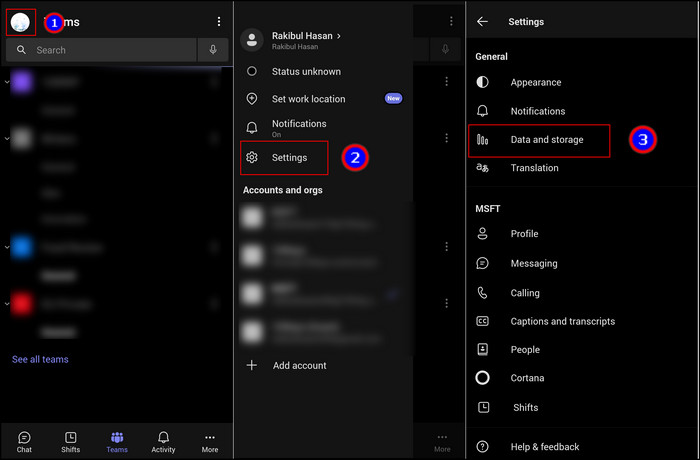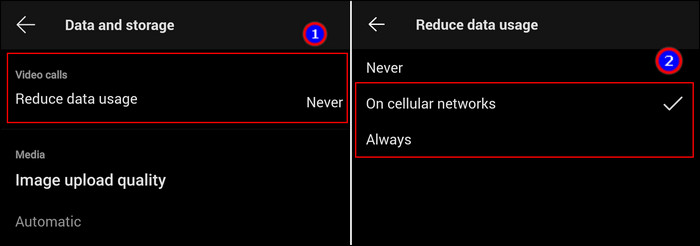Microsoft Teams has become a part of our remote work, and we can seamlessly join in a meeting or conference without worrying about the place.
But, if you are outside and relying on mobile data, you should keep track of your data usage because Microsoft Teams is well-known for eating data when delivering good video quality.
In this article, I’ll give an estimated data consumption of Microsoft Teams so that you can prepare yourself for a trouble-free outdoor meeting.
Without wasting any time, let’s start.
How Much Data Does Microsoft Teams Consume?
Microsoft Teams use 4.5 to 34.2 MB of data per hour for meetings and one-to-one audio calls. For the video call, it requires from 67.5 to 1800 MB and 90 MB to 1800 MB for screen sharing. In addition, Microsoft Teams need up to 1125 MB per hour for the Together Mode meetings.
I did a short experiment with data usage while writing this article. Before making a one-to-one video call in Microsoft Teams, I had a data consumption of 826 KB. After a 10-minute video call with my colleague, the data consumption has increased to 264,190 KB.
That means Microsoft Teams has consumed 245,364 KB or 245.364 MB of data in ten minutes of video call.
The following chart will break down the estimated data usage by Microsoft Teams in an hour at different audio and video quality.
Microsoft Teams Estimated Data Consumption (Per Hour):
| Audio | |||
|---|---|---|---|
| Type | Minimum | Recommended | Best Performance |
| One-to-one | 4.5 MB | 26.1 MB | 34.2 MB |
| Meetings | 4.5 MB | 26.1 MB | 34.2 MB |
| Video | |||
|---|---|---|---|
| Type | Minimum | Recommended | Best Performance |
| One-to-one | 67.5 MB | 675 MB | 1800 MB / 1.8 GB |
| Meetings | 67.5 MB | 1125 MB / 1.125 GB | 1800 MB / 1.8 GB |
| Screen Sharing | |||
|---|---|---|---|
| Type | Minimum | Recommended | Best Performance |
| One-to-one | 90 MB | 675 MB | 1800 MB / 1.8 GB |
| Meetings | 112.5 MB | 1125 MB / 1.125 GB | 1800 MB / 1.8 GB |
| Together Mode | |||
|---|---|---|---|
| Type | Minimum | Recommended | Best Performance |
| One-to-one | N/A | N/A | N/A |
| Meetings | 450 MB | 675 MB | 1125 MB / 1.125 GB |
When the data is limited, Microsoft Teams will lower the quality and prioritize the audio call over video and meetings.
In the lowest quality, Microsoft Teams will use 4.5 MB of data in 1 hour or 1.25 KB per second for the audio only. And for the video call, Teams will use 90 MB of data per hour or 25 KB per second (Kbps).
With no bandwidth limitation, Microsoft Teams will maximize the audio and video call quality to give the best user experience.
Microsoft Teams will use 34.2 MB per hour or 9.5 KB per second to give the best audio experience. For the video call and meetings, Teams will consume 1800 MB per hour or 500 KB per second (Kbps).
If you’re sharing screen and video simultaneously on MS Teams, it will use 112.5 MB at the lowest quality and 1.8 GB at the maximum.
Why Does Microsoft Teams Use So Much Data?
Microsoft Teams require a large amount of bandwidth to transfer or stream high-quality audio and video in calls or meetings. In HD video call at up to 1080p video resolution and 30fps video and content streaming, Microsoft Teams need around 2GB of data per hour.
Microsoft Teams audio and video call has three different qualities—minimum, recommended, and best performance. The data consumption in the minimum quality is less than most other communication platforms.
But the best performance requires a lot of data compared to others. For example, if there’s no bandwidth limitation and you’re on 4G or LTE, Microsoft Teams can consume 9 GB of your data in one hour.
The answer behind the high consumption rate lies in Microsoft Teams network bandwidth requirements.
Microsoft Teams Bandwidth Requirements (Kilobit/s up/down):
| Audio | |||
|---|---|---|---|
| Type | Minimum | Recommended | Best Performance |
| One-to-one | 10/10 | 58/58 | 76/76 |
| Meetings | 10/10 | 58/58 | 76/76 |
| Video | |||
|---|---|---|---|
| Type | Minimum | Recommended | Best Performance |
| One-to-one | 150/150 | 1,500/1,500 | 4,000/4,000 |
| Meetings | 150/200 | 2,500/4,000 | 4,000/4,000 |
| Screen Sharing | |||
|---|---|---|---|
| Type | Minimum | Recommended | Best Performance |
| One-to-one | 200/200 | 1,500/1,500 | 4,000/4,000 |
| Meetings | 250/250 | 2,500/2,500 | 4,000/4,000 |
| Together Mode | |||
|---|---|---|---|
| Type | Minimum | Recommended | Best Performance |
| One-to-one | N/A | N/A | N/A |
| Meetings | 1,000/1,500 | 1,500/2,500 | 2,500/4,000 |
The minimum requirement for the Microsoft Teams audio and video call is very optimal. But as soon as you increase the quality, it will consume more of your data.
The Teams meeting is associated with numerous services. Microsoft always tries to stream at the best possible quality using mobile, desktop, or web applications.
For this reason, they have mentioned a high-performance category in the bandwidth requirement. So that users can experience the best possible outcome from the calls.
As a result, Microsoft Teams may need 4000 Kilobits per second for download and upload to give you the best performance.
If you’re outside or have a data limitation, excessive data consumption may be a problem. You can reduce the data usage in Teams by following the methods below to get rid of the issue.
How to Reduce Data Usage on Microsoft Teams
Reducing data usage on Microsoft Teams is vital, especially when using a cellular network. You can minimize data consumption by accessing the Settings from the Microsoft Teams mobile application and reducing data usage from Data and storage.
If you’re out of the office or away from the Wi-Fi network, you can minimize the Microsoft Teams bandwidth by following the procedures below.
Here are the steps to reduce data usage on Microsoft Teams:
- Open Microsoft Teams mobile application.
- Press on the profile icon.
- Click on Settings.

- Navigate to Data and storage.
- Press in Reduce data usage.
- Choose On cellular networks or Always.

Now, the video call on your Android or iOS device will consume less data than before.
Unfortunately, laptop, desktop, and web applications don’t have a dedicated option to reduce data usage, as they primarily run on Wi-Fi networks.
Frequently Asked Questions
Is 1GB of data enough for MS Teams?
1GB of data is sufficient for Microsoft Teams to audio call at best performance. For the one-to-one video call, 1GB is enough to stream in recommended settings. But you’ll need to go with the minimum quality for meetings and screen sharing.
Does Microsoft Teams have a low data mode?
Yes, Microsoft Teams have a low data mode. You’ll find the option in the Teams mobile client on Android and iOS. However, the option isn’t available for desktop and web applications.
How much data does a 1-hour video call use in Microsoft Teams?
The one-to-one video call and meetings in Microsoft Teams require 67.5 MB at the lowest quality and 1800 MB at the best performance for one hour. If you’re screen sharing in Teams, it will consume from 112.5 MB to 1800 MB per hour.
Conclusion
Whenever we are outside and using mobile networks for meetings in Microsoft Teams, we must be conscious about data usage to avoid an unfortunate disconnection.
In this article, I’ve provided a chart on the data consumption by Microsoft Teams in one hour to give you an estimated bandwidth requirement. I hope you’ve found the article helpful and are using it to plan your outdoor meetings.
Cheers!



